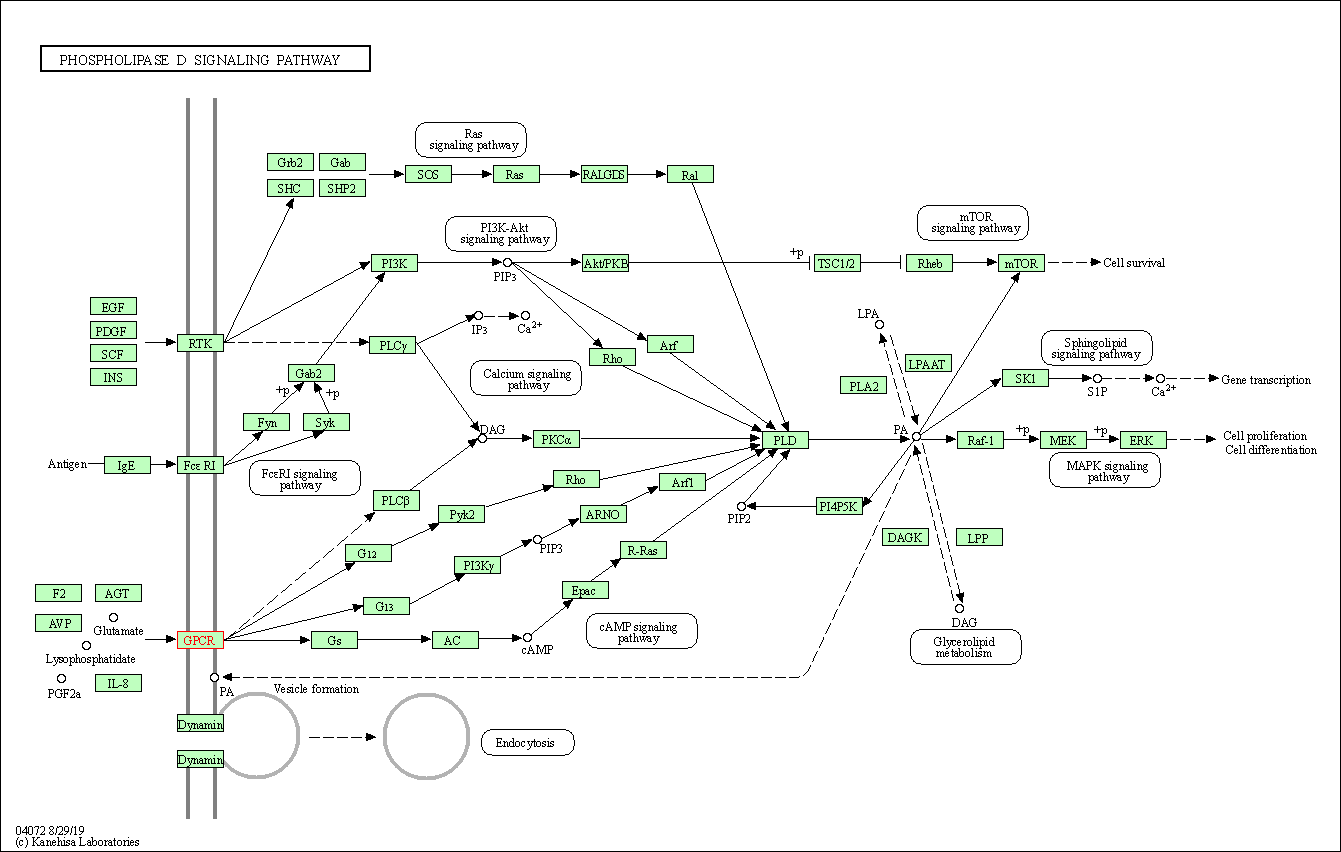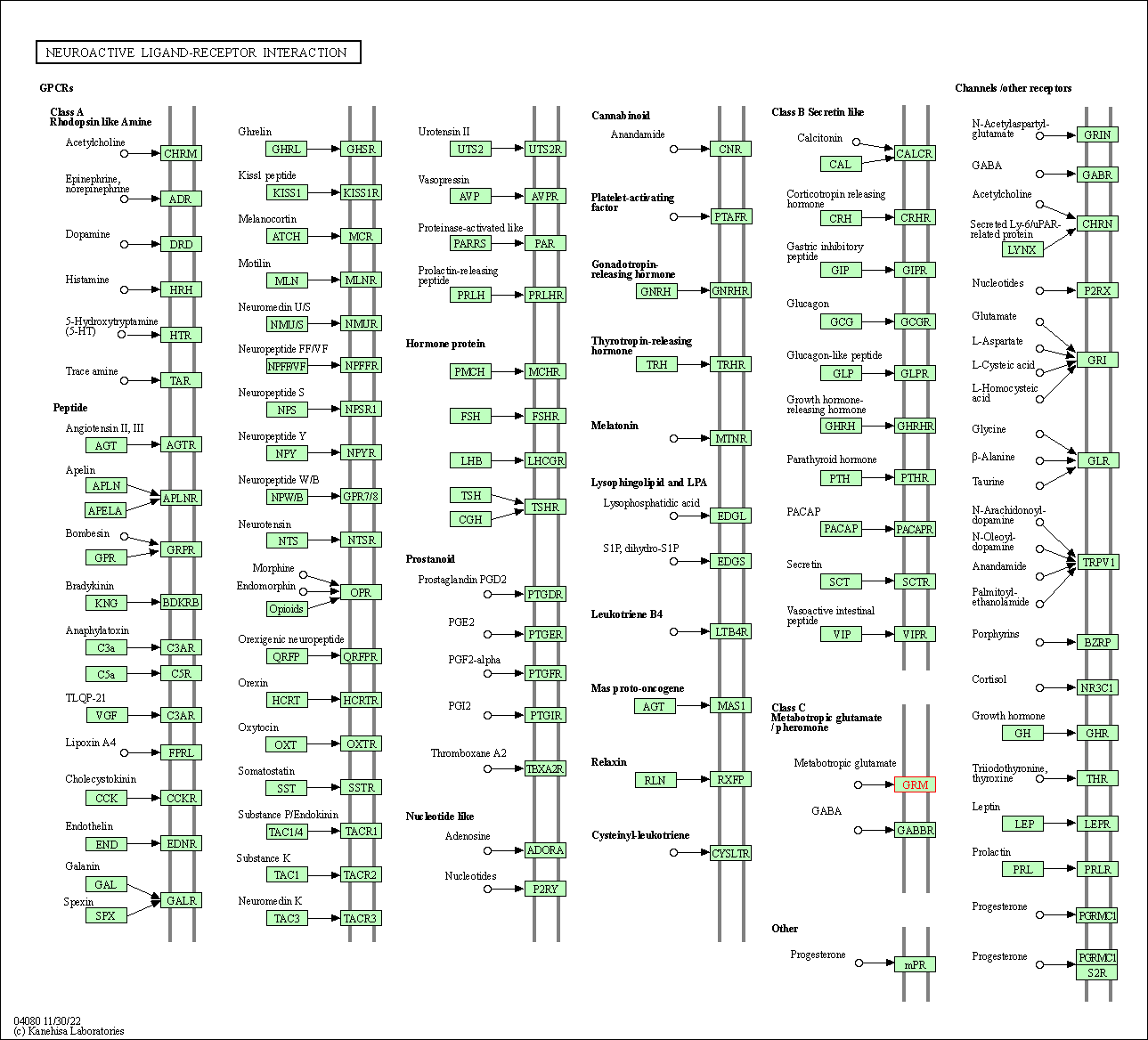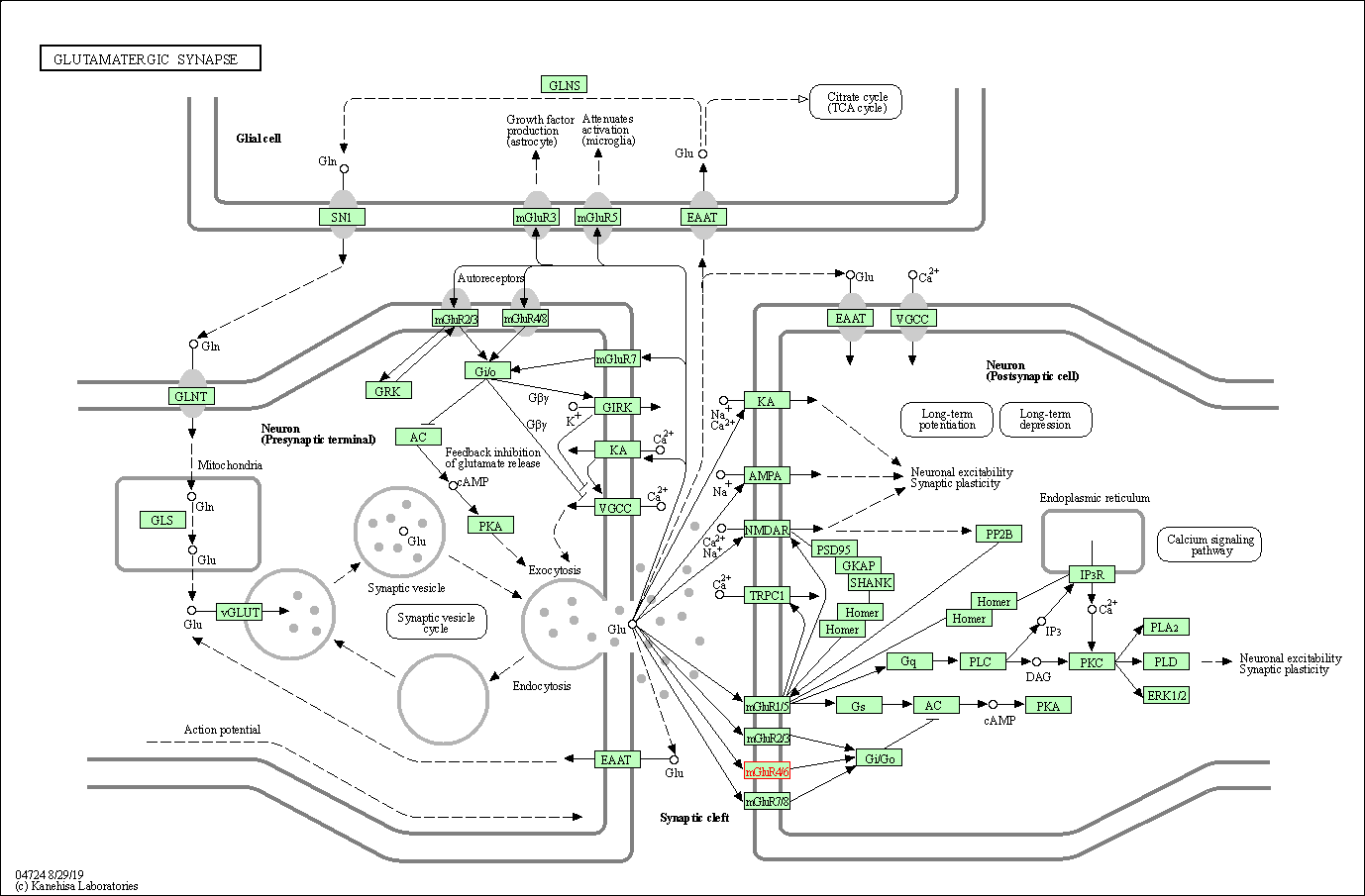Target Information
| Target General Information | Top | |||||
|---|---|---|---|---|---|---|
| Target ID |
T55956
(Former ID: TTDI03373)
|
|||||
| Target Name |
Metabotropic glutamate receptor 6 (mGluR6)
|
|||||
| Synonyms |
MGLUR6; GPRC1F
Click to Show/Hide
|
|||||
| Gene Name |
GRM6
|
|||||
| Target Type |
Literature-reported target
|
[1] | ||||
| Function |
G-protein coupled receptor for glutamate. Ligand binding causes a conformation change that triggers signaling via guanine nucleotide-binding proteins (G proteins) and modulates the activity of down-stream effectors, such as adenylate cyclase. Signaling inhibits adenylate cyclase activity (By similarity). Signaling stimulates TRPM1 channel activity and Ca(2+) uptake. Required for normal vision.
Click to Show/Hide
|
|||||
| BioChemical Class |
GPCR glutamate
|
|||||
| UniProt ID | ||||||
| Sequence |
MARPRRAREPLLVALLPLAWLAQAGLARAAGSVRLAGGLTLGGLFPVHARGAAGRACGQL
KKEQGVHRLEAMLYALDRVNADPELLPGVRLGARLLDTCSRDTYALEQALSFVQALIRGR GDGDEVGVRCPGGVPPLRPAPPERVVAVVGASASSVSIMVANVLRLFAIPQISYASTAPE LSDSTRYDFFSRVVPPDSYQAQAMVDIVRALGWNYVSTLASEGNYGESGVEAFVQISREA GGVCIAQSIKIPREPKPGEFSKVIRRLMETPNARGIIIFANEDDIRRVLEAARQANLTGH FLWVGSDSWGAKTSPILSLEDVAVGAITILPKRASIDGFDQYFMTRSLENNRRNIWFAEF WEENFNCKLTSSGTQSDDSTRKCTGEERIGRDSTYEQEGKVQFVIDAVYAIAHALHSMHQ ALCPGHTGLCPAMEPTDGRMLLQYIRAVRFNGSAGTPVMFNENGDAPGRYDIFQYQATNG SASSGGYQAVGQWAETLRLDVEALQWSGDPHEVPSSLCSLPCGPGERKKMVKGVPCCWHC EACDGYRFQVDEFTCEACPGDMRPTPNHTGCRPTPVVRLSWSSPWAAPPLLLAVLGIVAT TTVVATFVRYNNTPIVRASGRELSYVLLTGIFLIYAITFLMVAEPGAAVCAARRLFLGLG TTLSYSALLTKTNRIYRIFEQGKRSVTPPPFISPTSQLVITFSLTSLQVVGMIAWLGARP PHSVIDYEEQRTVDPEQARGVLKCDMSDLSLIGCLGYSLLLMVTCTVYAIKARGVPETFN EAKPIGFTMYTTCIIWLAFVPIFFGTAQSAEKIYIQTTTLTVSLSLSASVSLGMLYVPKT YVILFHPEQNVQKRKRSLKATSTVAAPPKGEDAEAHK Click to Show/Hide
|
|||||
| 3D Structure | Click to Show 3D Structure of This Target | AlphaFold | ||||
| Cell-based Target Expression Variations | Top | |||||
|---|---|---|---|---|---|---|
| Cell-based Target Expression Variations | ||||||
| Different Human System Profiles of Target | Top |
|---|---|
|
Human Similarity Proteins
of target is determined by comparing the sequence similarity of all human proteins with the target based on BLAST. The similarity proteins for a target are defined as the proteins with E-value < 0.005 and outside the protein families of the target.
A target that has fewer human similarity proteins outside its family is commonly regarded to possess a greater capacity to avoid undesired interactions and thus increase the possibility of finding successful drugs
(Brief Bioinform, 21: 649-662, 2020).
Human Pathway Affiliation
of target is determined by the life-essential pathways provided on KEGG database. The target-affiliated pathways were defined based on the following two criteria (a) the pathways of the studied target should be life-essential for both healthy individuals and patients, and (b) the studied target should occupy an upstream position in the pathways and therefore had the ability to regulate biological function.
Targets involved in a fewer pathways have greater likelihood to be successfully developed, while those associated with more human pathways increase the chance of undesirable interferences with other human processes
(Pharmacol Rev, 58: 259-279, 2006).
Human Similarity Proteins
Human Pathway Affiliation
|
|
|
There is no similarity protein (E value < 0.005) for this target
|
| KEGG Pathway | Pathway ID | Affiliated Target | Pathway Map |
|---|---|---|---|
| Phospholipase D signaling pathway | hsa04072 | Affiliated Target |

|
| Class: Environmental Information Processing => Signal transduction | Pathway Hierarchy | ||
| Neuroactive ligand-receptor interaction | hsa04080 | Affiliated Target |

|
| Class: Environmental Information Processing => Signaling molecules and interaction | Pathway Hierarchy | ||
| Glutamatergic synapse | hsa04724 | Affiliated Target |

|
| Class: Organismal Systems => Nervous system | Pathway Hierarchy | ||
| Chemical Structure based Activity Landscape of Target | Top |
|---|---|
| Drug Property Profile of Target | Top | |
|---|---|---|
| (1) Molecular Weight (mw) based Drug Clustering | (2) Octanol/Water Partition Coefficient (xlogp) based Drug Clustering | |
|
|
||
| (3) Hydrogen Bond Donor Count (hbonddonor) based Drug Clustering | (4) Hydrogen Bond Acceptor Count (hbondacc) based Drug Clustering | |
|
|
||
| (5) Rotatable Bond Count (rotbonds) based Drug Clustering | (6) Topological Polar Surface Area (polararea) based Drug Clustering | |
|
|
||
| "RO5" indicates the cutoff set by lipinski's rule of five; "D123AB" colored in GREEN denotes the no violation of any cutoff in lipinski's rule of five; "D123AB" colored in PURPLE refers to the violation of only one cutoff in lipinski's rule of five; "D123AB" colored in BLACK represents the violation of more than one cutoffs in lipinski's rule of five | ||
| Target Poor or Non Binders | Top | |||||
|---|---|---|---|---|---|---|
| Target Poor or Non Binders | ||||||
| References | Top | |||||
|---|---|---|---|---|---|---|
| REF 1 | URL: http://www.guidetopharmacology.org Nucleic Acids Res. 2015 Oct 12. pii: gkv1037. The IUPHAR/BPS Guide to PHARMACOLOGY in 2016: towards curated quantitative interactions between 1300 protein targets and 6000 ligands. (Target id: 294). | |||||
| REF 2 | (S)-3,4-DCPG, a potent and selective mGlu8a receptor agonist, activates metabotropic glutamate receptors on primary afferent terminals in the neonatal rat spinal cord. Neuropharmacology. 2001 Mar;40(3):311-8. | |||||
| REF 3 | The metabotropic glutamate receptors: structure, activation mechanism and pharmacology. Curr Drug Targets CNS Neurol Disord. 2002 Jun;1(3):297-317. | |||||
| REF 4 | A new highly selective metabotropic excitatory amino acid agonist: 2-amino-4-(3-hydroxy-5-methylisoxazol-4-yl)butyric acid. J Med Chem. 1996 Aug 2;39(16):3188-94. | |||||
| REF 5 | Cloning, distribution and functional expression of the human mGlu6 metabotropic glutamate receptor. Neuropharmacology. 1997 Feb;36(2):145-52. | |||||
| REF 6 | A novel selective metabotropic glutamate receptor 4 agonist reveals new possibilities for developing subtype selective ligands with therapeutic potential. FASEB J. 2012 Apr;26(4):1682-93. | |||||
| REF 7 | The mGlu(4) receptor allosteric modulator N-phenyl-7-(hydroxyimino)cyclopropa[b]chromen-1a-carboxamide acts as a direct agonist at mGlu(6) receptors. Eur J Pharmacol. 2008 Jul 28;589(1-3):49-52. | |||||
| REF 8 | Binding of [3H](2S,1'S,2'S)-2-(9-xanthylmethyl)-2-(2'-carboxycyclopropyl) glycine ([3H]LY341495) to cell membranes expressing recombinant human group III metabotropic glutamate receptor subtypes. Naunyn Schmiedebergs Arch Pharmacol. 2000 Dec;362(6):546-54. | |||||
If You Find Any Error in Data or Bug in Web Service, Please Kindly Report It to Dr. Zhou and Dr. Zhang.

